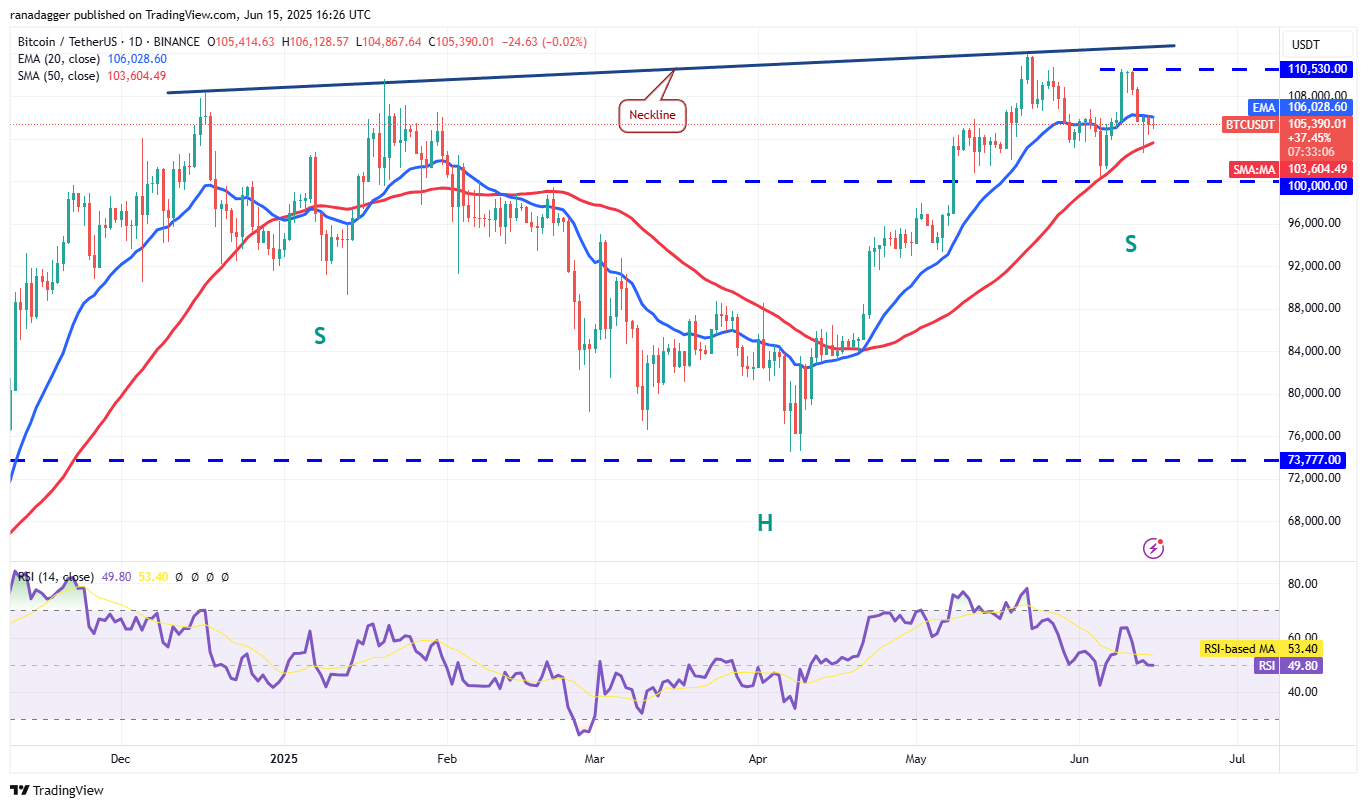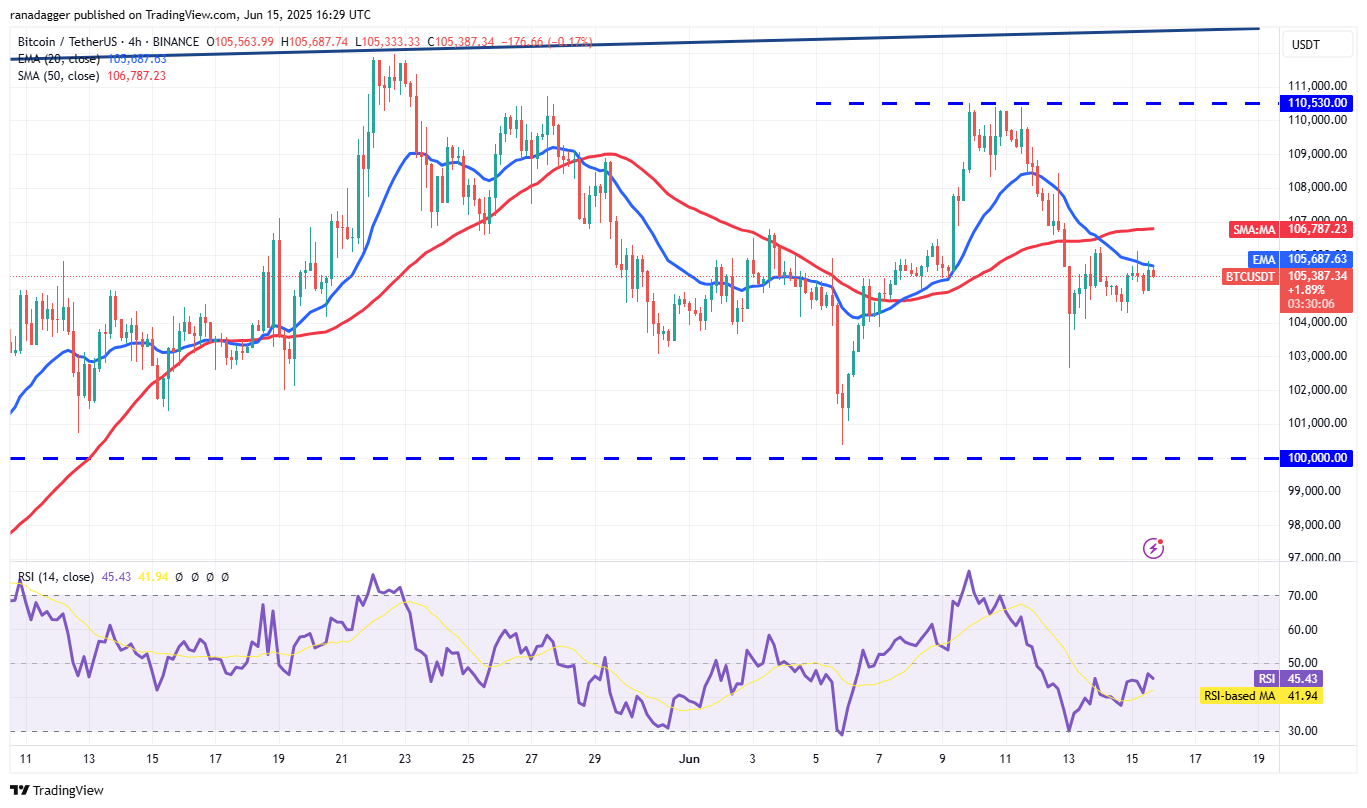The increase in the proportion of long-term holders and the participation of institutional investors has transformed it from a speculative asset into a liquidity hedging tool.
Written by: Mars Finance
Introduction: The Mystery of Digital Asset Resilience in Turbulent Times
In June 2025, the global financial markets are undergoing an epic stress test: Ukrainian drones destroy 41 nuclear bombers, triggering fears of nuclear proliferation; the China-U.S. tariff war reignites; missiles streak across the Middle East night sky… Traditional safe-haven asset gold breaks through $3,450 per ounce, nearing new highs, while Bitcoin demonstrates astonishing stability at the $105,000 mark. This performance, which is "desensitized" to geopolitical crises, reflects profound changes in the underlying logic of the crypto market. This article will decode Bitcoin's survival rules amid macro shocks from three dimensions: market structure, macro cycles, and the reconstruction of monetary order.
1. The Failure of the Transmission Mechanism of Geopolitical Shocks: From Panic Amplifier to Risk Isolator
1. The "Dulling Effect" of Conflict Shocks
In the June 13 Israeli airstrike on Iranian nuclear facilities, Bitcoin fell 2% within two hours but quickly stabilized, contrasting sharply with the 10% drop seen during the Russia-Ukraine conflict in 2022. This enhanced resilience stems from a qualitative change in market structure: Glassnode data shows that in 2025, the proportion of long-term holders (LTH) surpassed 70%, while speculative chips dropped to a five-year low. The hedging system established by institutional investors through the derivatives market effectively buffered the instantaneous impact of sudden events.
2. The Paradigm Shift in Hedging Logic
The traditional perception of Bitcoin as "digital gold" is being redefined. With expectations of a Federal Reserve interest rate cut cycle, the negative correlation (-0.72) between Bitcoin and the real yield of 10-year U.S. Treasuries has significantly strengthened, making it more akin to a "liquidity hedging tool" rather than merely a safe-haven asset. When the U.S. Treasury auction on June 1 faced weak demand, causing real rates to soar, Bitcoin's reverse rally validated this new attribute.
3. The "Directional Absorption" of Geopolitical Premiums
The energy supply chain crisis triggered by Middle Eastern conflicts has objectively accelerated the de-dollarization process. The proportion of Iran's oil exports settled in Bitcoin has exceeded 15%, and this penetration into the real economy has partially transformed geopolitical risks into rigid demand for Bitcoin. Blockchain analysis firm Chainalysis reports that the on-chain transaction volume of wallet addresses in conflict areas surged by 300% after the events.
2. The Nested Game of Macro Cycles: Dual Boost from Rate Cut Expectations and Inflation Relief
1. The Certainty Dividend of Monetary Policy Shift
CME FedWatch Tool indicates that the market's expectation of a rate cut in Q3 has reached 68%, which is directly reflected in the steepening of Bitcoin's term structure: the annualized premium of the June 15 futures contract rose to 23%, a new high since the 2024 halving. Historical data shows that in the three months leading up to the start of a rate cut cycle, Bitcoin's average increase reached 37%, far exceeding gold's 12%.
2. Structural Resolution of Inflation Stickiness
The core PCE price index in May fell to 2.8% year-on-year, and the Supply Chain Pressure Index (GSCPI) returned to pre-pandemic levels. This weakened Bitcoin's anti-inflation narrative but unexpectedly released its "growth-sensitive asset" attribute. MicroStrategy's latest financial report shows that the accounting treatment of corporate Bitcoin holdings has shifted from "intangible assets" to "strategic reserves," marking the beginning of institutions incorporating it into growth stock valuation frameworks.
3. Arbitrage Opportunities from Diverging Policies between China and the U.S.
The People's Bank of China has increased its gold reserves for six consecutive months to 30,000 ounces, while the U.S. Treasury has driven the dollar index down 12% this year through a "controlled devaluation" strategy. This divergence in monetary policy has created a gray channel for cross-border capital to arbitrage through Bitcoin. Chainalysis has detected a 470% increase in Bitcoin OTC trading volume along the China-U.S. trade corridor during the tariff dispute.
3. Deep Structural Changes in the Market: From Retail Frenzy to Institutional Pricing
1. The "De-leveraging" of Position Structure
In 2025, the proportion of hedging positions in futures open interest has surpassed 60% for the first time, and the funding rate for perpetual contracts has remained stable below 0.01% per day. This change means that the market no longer relies on leveraged funds for momentum, and the "double explosion" phenomenon of long and short positions common in 2021 has largely disappeared. BlackRock's Bitcoin ETF has surpassed $130 billion in assets under management, with its daily net subscription volume showing a significant negative correlation with the S&P 500 Volatility Index (VIX).
2. The "Layered Reinforcement" of Liquidity Structure
Coinbase's institutional custody account balance has exceeded 4 million Bitcoins, accounting for about 21% of the circulating supply. These "cold storage" chips form a natural price stabilizer, making it difficult for short-term selling pressure to breach key support levels. When panic selling occurred on June 14 due to the Iranian missile attack, over $3 billion in buy orders emerged at the $100,000 mark, with 90% coming from institutional OTC desks.
3. The "Traditional Integration" of Valuation Systems
The 90-day correlation between Bitcoin and the Nasdaq 100 index has dropped from 0.85 in 2021 to 0.32, while its correlation with the Russell 2000 small-cap stocks has risen to 0.61. This shift reflects the market's reconstruction of valuation logic using traditional asset pricing models: Bitcoin's volatility (annualized at 45%) is now close to that of tech growth stocks, far lower than the 128% seen in 2021.
4. Short-term Price Analysis
Bitcoin found support at the 50-day simple moving average ($103,604) on Friday, but bulls struggled to push the price above the 20-day exponential moving average ($106,028). This indicates a lack of buying interest at high levels.

BTC/USDT Daily Chart. Source: TradingView
According to the BTC/USDT daily chart, the 20-day moving average is flattening, and the relative strength index (RSI) is near the midpoint, providing no clear advantage to either bulls or bears. If buyers push the price above the 20-day moving average, the BTC/USDT pair could rise to the $110,530 to $111,980 range. Sellers are expected to defend this upper area vigorously, but if bulls gain the upper hand, the pair could soar to $130,000.
On the downside, a drop below the 50-day moving average (SMA) could challenge the key psychological level of $100,000. If this level is breached, the pair could fall to $93,000.

BTC/USDT 4-Hour Chart. Source: TradingView
Sellers are attempting to prevent a price rebound at the 20-day moving average (EMA) on the 4-hour chart. If the price drops significantly and falls below $104,000, the short-term advantage will shift to bears. The pair could drop to $102,664 and then to $100,000. Buyers are expected to defend the $100,000 level vigorously.
Bulls must push the price above the 50-day moving average (SMA) to gain control. After that, the pair could surge to $110,530.
5. Future Path Projection: Summer Dormancy and Autumn Offensive
1. June-August: Period of Consolidation
The Federal Reserve's policy vacuum may cause Bitcoin to oscillate in the $98,000-$112,000 range. A key observation point will be whether the July FOMC meeting releases clear signals for a rate cut; technically, the 200-day moving average (currently at $96,500) will provide strong support. The pulse-like impact of geopolitical conflicts still exists, but market depth indicators show that the amount of capital required for a 1% price fluctuation has increased to three times that of 2022.
2. September-November: Initiation of Main Uptrend
Historical seasonal patterns show that the average increase in October is 21.89%, combined with the Federal Reserve's potential first rate cut, Bitcoin may embark on a journey to challenge $150,000. At that time, the peak of U.S. Treasury maturities ($6.5 trillion) may force the Federal Reserve to expand its balance sheet, and the secondary release of dollar liquidity will become the best catalyst. The options market has seen a significant accumulation of call options expiring in December with a strike price of $140,000.
3. Risk Warning: Regulatory Gray Rhino
The SEC's enforcement action against stablecoin issuer Paxos may trigger short-term volatility, but in the long run, the normalization of spot ETF approvals will attract over $200 billion in traditional asset management funds. Investors should be wary of a "Christmas pullback" after a November surge; historical data shows that the average drawdown during this phase of a bull market cycle reaches 18%.
Conclusion: Bitcoin's Positioning in the New Monetary Order
As gold approaches $3,500, the U.S. Treasury yield curve remains inverted, and the proportion of cross-border settlements in renminbi surpasses that of the dollar, we are witnessing the most profound monetary revolution since the collapse of the Bretton Woods system. Bitcoin plays a dual role in this transformation: it is both a beneficiary of the collapse of the old system's credit and a builder of the infrastructure for the new order. Its price stability no longer stems from reduced volatility but from the reconstruction of underlying value support—evolving from a speculative symbol into a liquidity bridge connecting the real economy. Perhaps, as Ray Dalio of Bridgewater Associates said, "In the long winter of the reconstruction of the fiat currency order, Bitcoin is proving to be the most frost-resistant seedling."
免责声明:本文章仅代表作者个人观点,不代表本平台的立场和观点。本文章仅供信息分享,不构成对任何人的任何投资建议。用户与作者之间的任何争议,与本平台无关。如网页中刊载的文章或图片涉及侵权,请提供相关的权利证明和身份证明发送邮件到support@aicoin.com,本平台相关工作人员将会进行核查。




